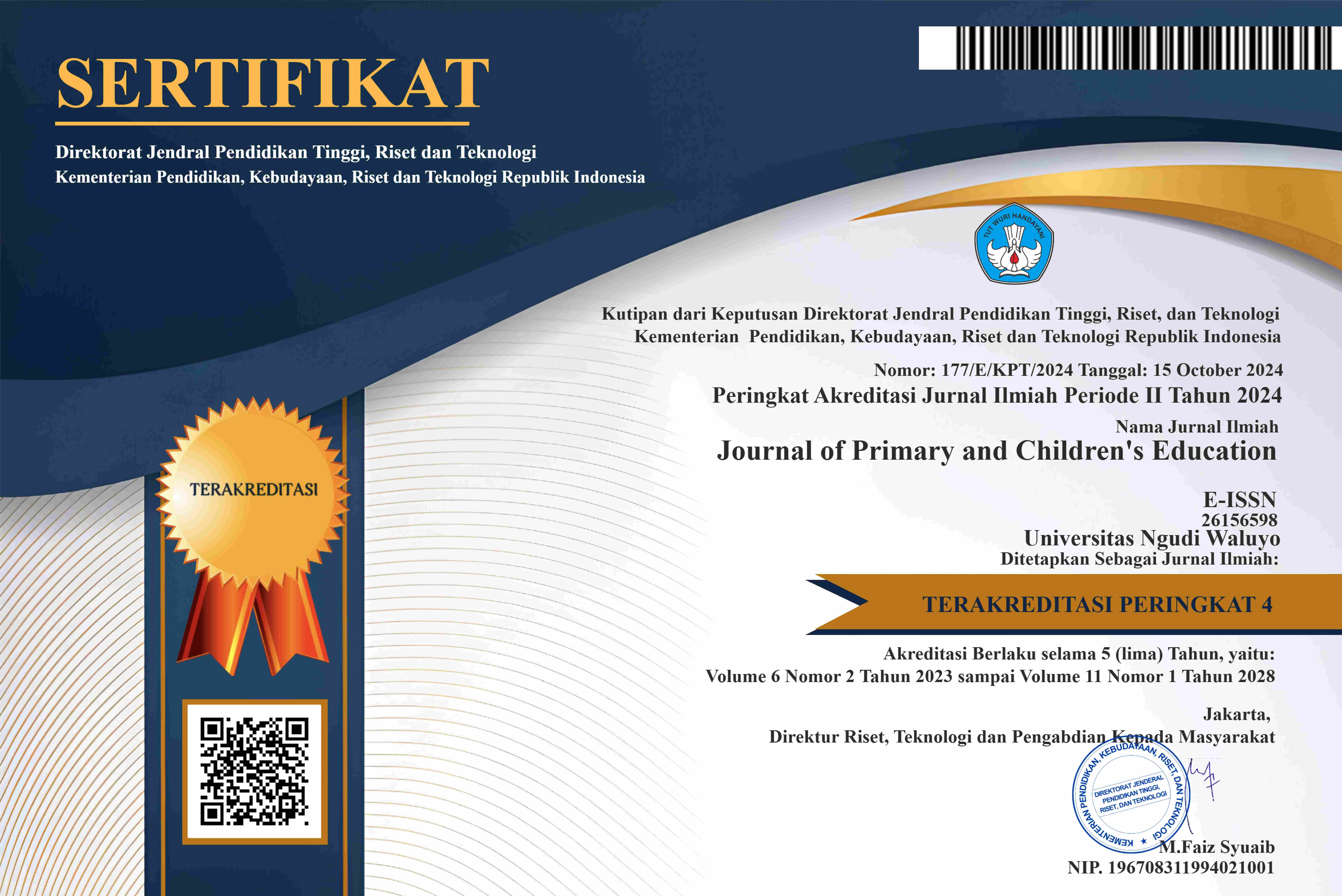Keefektifan Model Pembelajaran Make A Match Menggunakan Media Paperku Terhadap Keaktifan Siswa Kelas III SD Negeri 02 Sitemu Pemalang
DOI:
https://doi.org/10.35473/jnctt.v1i2.49Abstract
Abstrak
Tujuan penelitian ini adalah untuk mengetahui ada atau tidaknya keefektifan penggunaan model pembelajaran Make A Match menggunakan media paperku ( Papan perkalianku) terhadap keaktifan siswa kelas III SDN 02 Sitemu Kabupaten Pemalang, metode penelitian yang digunakan adalah metode eksperimen. Desain penelitian yang digunakan dalam penelitian ini adalah Pre-Experimental Designs (nondesigns) dengan bentuk desain penelitian yang digunakan adalah one-group pretest-posttest design dengan sampel penelitian yaitu seluruh siswa kelas III SD N 02 Sitemu Kabupaten Pemalang yang berjumlah 20 anak. Hasil dari penelitian ini yaitu Berdasarkan hasil penelitian yang telah dilakukan dapat disimpulkan bahwa model Make a Match efektif terhadap keaktifan siswa kelas III SDN 02 Sitemu Kabupaten Pemalang. Hal ini didukung oleh data-data berikut yang dilihat dari: (1) terjadi peningkatan hasil belajar terutama dalam hal pemahaman berhitung siswa kelas III SDN 02 Sitemu sebelum dan sesudah perlakuan. Hal ini berdasarkan analisis data hasil penelitian dengan menggunakan uji-t diperoleh thitung > ttabel yaitu 4,121576 > 2,093 maka H0 ditolak dan Ha diterima. (2) hasil belajar siswa mencapai kriteria ketuntasan belajar siswa melalui nilai posttest sebanyak 17 siswa 100% telah mencapai ketuntasan minimal individu sebagai hasil dari penggunaan model Make a Match. Hal ini dapat disimpulkan bahwa H0 ditolak (Rata-rata nilai pemahaman berhitung siswa sebelum dan sesudah perlakuan tidak sama) artinya model Make a Match efektif terhadap keaktifan siswa kelas III SDN 02 Sitemu.
Â
               Kata kunci: Keefektifan, Model Make a Match, dan Keakrifan Siswa.
Abstract
The purpose of this study is to determine whether or not the effectiveness of the use of Make A Match learning model using media paperku (multiplication board) on the activity of third grade students SDN 02 Sitemu Pemalang District, research method used is experimental method. The research design used in this research is Pre-Experimental Designs (nondesigns) with the research design that used is one-group pretest-posttest design with the research sample that is all students of class III SD N 02 Sitemu Pemalang Regency amounting to 20 children. The results of this study are based on the results of the research that has been done it can be concluded that the Make a Match model is effective against the activeness of third grade students of SDN 02 Sitemu Pemalang Regency. This is supported by the following data which are seen from: (1) there is an increase in learning outcome, especially in terms of understanding of numeracy grade students of SDN 02 Sitemu before and after treatment. This is based on the analysis of research data using the t-test obtained by t count> t table that is 4.121576> 2.093 then H0 is rejected and Ha is accepted. (2) student learning outcomes reach student learning completeness criteria through posttest value as much as 17 students 100% have reached minimum masculinity of individual as result of use of Make a Match model. It can be concluded that H0 is rejected (Average score of students' understanding comprehension before and after unequal treatment) means Make a Match model is effective on student activity of class III SDN 02 Sitemu.
Â
Keywords: Effectiveness, Make a Match Model, and Student Achievement.
References
DAFTAR PUSTAKA
Sugiyono. 2015. Metode Penelitian Kuantitatif, Kualitatif, dan R&D. Bandung: Alfabeta, CV
Margono.2010.Metodologi Penelitian Pendidikan.Jakarta:Rineka Cipta
Boyer, Carl B. (revised by Merzbach, Uta C.) (1991). History of Mathematics. John Wiley and Sons, Inc. ISBN 0-471-54397-7.
Muhsetyo,Gatot.2008.Pembelajaran Matematika SD.Jakarta:Universitas Terbuka.
Anton,M Mulyono.2007.Kamus Besar Bahasa Indonesia.Jakarta:Balai Pustaka.
Depdikbud.2006.Kamus Besar Bahasa Indonesia. Jakarta:Balai Pustaka.
Slameto.2003. Belajar dan Faktor-faktor yang Mempengaruhinya. Bandung: Pustaka Husada.
Suharmanto. 2015.Pengembangan Media Pembelajaran Papan Hitung Pembagian Pada Mata Pelajaran Matematika SD Kelas 2. http//journal.student.uny.ac.id/ojs/index.php/fiptp/article/view/141.Diakses pada tanggal 2 April 2017.
Subekti,Ervina Eka.Statistika 2.Semarang:Jurusan PGSD FIP Universitas PGRI Semarang.
Suhana,Cucu.Konsep Strategi Pembelajaran.Bandung:PT Refika Aditama.
Arianti, Riska. 2010. Penarapan Model Pembelajaran Kooperatif Make A Match Pada Mata Pelajaran Matematika Siswa Kelas VII SMPN 1 Porong. Skripsi (Tidak diterbitkan). Jurusan Pendidikan Matematika.Fakultas Keguruan dan Ilmu Pendidikan.Universitas Muhamadiah Malang. Tersedia pada http://digilib.umm.ac.id/files/disk1/372/jiptummpp-gdl-s1-2010-riskaarian-18597 BAB+1.pdf (diakses tanggal 27 november 2011).
Herdian. 2009. Model Pembelajaran Make A Match. Tersedia pada http://herdy09.wordpress.com/2009/04/29/model-pembelajaran-make-a-match/(diakses tanggal 27 November 2011).
Suprijono, Agus. 2012. Cooperative Learning. Jakarta: Pustaka Pelajar.
Suprijono, Agus. 2011. Cooperative Learning Teori dan Aplikasi Paikem. Yogyakarta: Pustaka pelajar.
Published
How to Cite
Issue
Section
License
Copyright notice:
- Authors retain copyright and grant the journal right of first publication with the work simultaneously licensed under Creative Commons Attribution License that allows others to share the work with an acknowledgement of the work's authorship and initial publication in this journal.
- Authors are able to enter into separate, additional contractual arrangements for the non-exclusive distribution of the journal's published version of the work (e.g., post it to an institutional repository or publish it in a book), with an acknowledgement of its initial publication in this journal.
- Authors are permitted and encouraged to post their work online (e.g., in institutional repositories or on their website) prior to and during the submission process, as it can lead to productive exchanges, as well as earlier and greater citation of published work (The Effect of Open Access)







